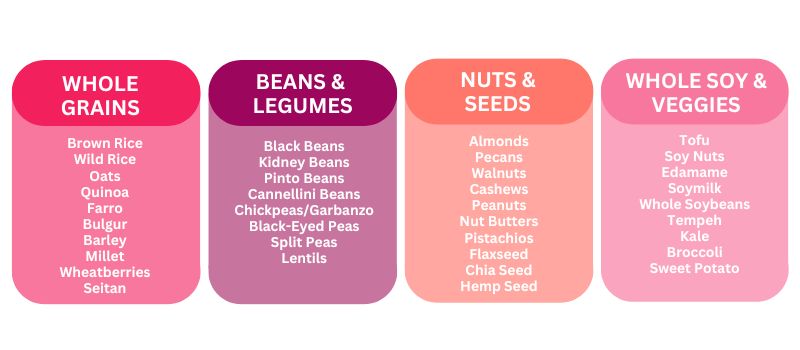With benefits to our health and the environment, plant proteins are worth their weight in gold. The ability to produce enough nutrient-dense food to feed people and maintain the health of the soil on our great, green earth is crucial to our future. Contributing a much lower carbon footprint than their animal-based counterparts, plants can still be satisfying, delicious and help meet your daily protein needs. Variety, quality and a bit of prowess in the kitchen are the key ingredients to powering up with plant-based proteins.
Going meatless doesn’t mean burning out on beans. There are a variety of legumes (including options beyond the common black or kidney bean), nuts, seeds, whole grains, whole soy foods and vegetables that keep things interesting in the kitchen. Consider exploring the following categories and trying something new!

Note: Some of these foods fit multiple categories (i.e. peanuts and soybeans are technically legumes.) These are grouped by nutritional relevance for ease and understanding.
BENEFITS
Lower carbon footprint
It’s likely that the carbon footprint of your food choices isn’t something you consider daily. While this topic flies a bit under the mainstream radar, it’s a growing and important topic crucial to a food-secure future. Organizations around the globe are working to assess the environmental impact of producing food, from the amount of water it requires to the greenhouse gas emissions production contributes. It can be difficult to get exact values on food because there are many contributing variables, but one this is certain – it takes many more resources and has a greater environmental impact to produce animal products, especially meat. Making a collective shift to a higher percentage of plant proteins compared to animal proteins will make your plate more earth-friendly.
Higher fiber
Beans, nuts, whole grains. These foods are in different food groups yet have two major things in common; they are all sources of plant-based protein and are high in fiber. Getting a dose of fiber with your protein choice is beneficial since most Americans don’t meet the recommended 24 – 38 grams of fiber each day. Moving toward more meatless meals can help you reach your fiber goals, leading to more stable blood sugar and energy levels and improved gut health.
Protein AND… (i.e. iron, healthy fats, magnesium, etc.)
Just as many plant-based proteins are bringing fiber to the table, they also pack a punch when it comes to other essential vitamins, minerals and nutrients. Nuts and seeds bring healthy fats and inflammation-fighting omega-3’s, while whole grains add zinc, magnesium and iron to the plate. Whole soy, like edamame, gives you blood pressure-regulating isoflavones. It can be a challenge to meet your nutrient needs through food, and prioritizing plant proteins can help you hit the mark.
Lower Disease Risk
One main factor that determines disease risk is diet, namely, how nutrient-dense and high fiber your food choices are. The Mediterranean Diet, as well as the DASH Eating Plan and MIND diet, are all very “plant-forward,” meaning while they’re not completely free of animal products, they are based primarily on whole plant foods. Swapping the typical entrée fare to sustainable, high-fiber plant options can lower your overall chronic disease risk when enjoyed consistently.
TIPS FOR FUELING FULLY WITH PLANT PROTEINS
Prioritizing plant-heavy meals doesn’t have to mean feeling constantly hungry! If meatless meals leave you wanting more, forge ahead with these RD-approved tips to plan nutrient-dense meals that leave you energized and satisfied.
Combine Plant Proteins
While it’s true you can meet your nutrient needs using plant proteins, it pays off to focus on variety and diversity to bring a complete amino acid profile to your plate. Plant proteins are “incomplete” proteins, meaning they don’t have all of the essential amino acids, or protein building blocks, that our bodies need. Pairing plants can round out your proteins and leave you feeling more satisfied with your meal.
- Try our Tangy Quinoa and Black Bean Salad
- Pair edamame and cashews in an easy stir fry
- Toss almonds and toasted chickpeas with greens for a heartier salad
Build Out Your Plate
Many plant proteins provide your body with energy via complex carbs, like beans and whole grains, and intentionally adding a source of healthy fat and fiber can make that meal “stick” a bit better, increasing vitamin and mineral intake and satiety. Look to nuts, seeds, avocado and healthy oils for satiety-increasing fats, and pile on the vegetables to add fiber. Look to greens, cruciferous vegetables (cabbage, kale, Brussels sprouts, arugula, broccoli, cauliflower), mushrooms, peppers, carrots, onions and so much more! Vegetables add fiber to your plate, which supports gut health, promotes blood sugar balance and boosts feelings of fullness.
Keep Balanced Snacks on Hand
Planning for your fueling needs is a key component of a sustainable, flexible meal plan. Plant foods tend to be high in nutrient density but are often lower in calorie density than processed foods. When you make the move to whole foods you might notice a shift in your hunger cues. This doesn’t mean eating plant-forward meals will always leave you hungry, but it might mean a bit more attention to balanced snacks to fuel your body will help you feel your best. Try pairing produce with plant protein or healthy fat for the ultimate snack. Try an apple with peanut butter, a clementine with edamame or bell pepper strips with hummus.
Take a peek at how to make the delicious Tangy Quinoa & Black Bean Salad at home!

Sarah VanEerden is a Registered Dietitian and a Marketing Specialist with Vitality. She earned her B.S. at Michigan State University and has a passion for making the healthy choice the easy choice. She’s an experimental cook and a terrible baker, and she loves diving into home improvement projects and music in her free time.






